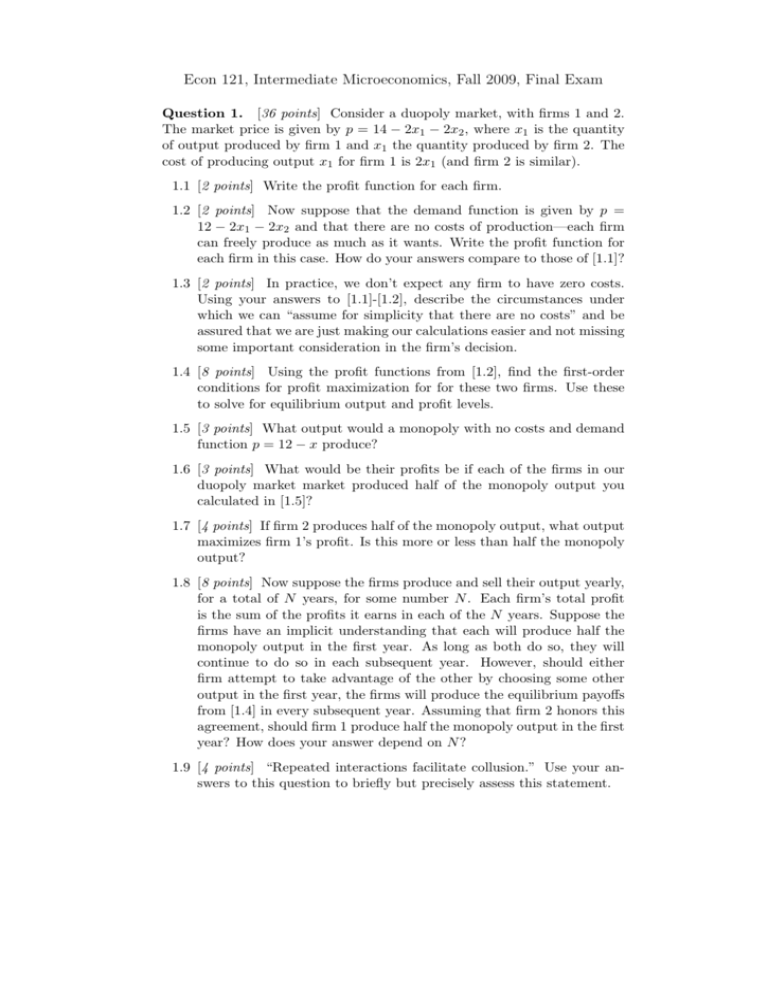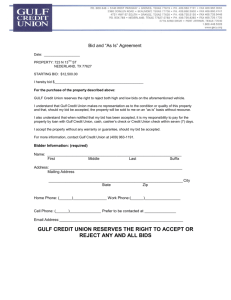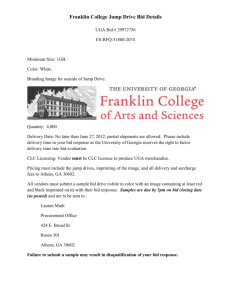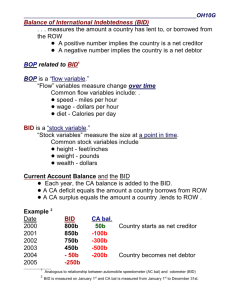Econ 121, Intermediate Microeconomics, Fall 2009, Final Exam
advertisement

Econ 121, Intermediate Microeconomics, Fall 2009, Final Exam Question 1. [36 points] Consider a duopoly market, with firms 1 and 2. The market price is given by p = 14 − 2x1 − 2x2 , where x1 is the quantity of output produced by firm 1 and x1 the quantity produced by firm 2. The cost of producing output x1 for firm 1 is 2x1 (and firm 2 is similar). 1.1 [2 points] Write the profit function for each firm. 1.2 [2 points] Now suppose that the demand function is given by p = 12 − 2x1 − 2x2 and that there are no costs of production—each firm can freely produce as much as it wants. Write the profit function for each firm in this case. How do your answers compare to those of [1.1]? 1.3 [2 points] In practice, we don’t expect any firm to have zero costs. Using your answers to [1.1]-[1.2], describe the circumstances under which we can “assume for simplicity that there are no costs” and be assured that we are just making our calculations easier and not missing some important consideration in the firm’s decision. 1.4 [8 points] Using the profit functions from [1.2], find the first-order conditions for profit maximization for for these two firms. Use these to solve for equilibrium output and profit levels. 1.5 [3 points] What output would a monopoly with no costs and demand function p = 12 − x produce? 1.6 [3 points] What would be their profits be if each of the firms in our duopoly market market produced half of the monopoly output you calculated in [1.5]? 1.7 [4 points] If firm 2 produces half of the monopoly output, what output maximizes firm 1’s profit. Is this more or less than half the monopoly output? 1.8 [8 points] Now suppose the firms produce and sell their output yearly, for a total of N years, for some number N . Each firm’s total profit is the sum of the profits it earns in each of the N years. Suppose the firms have an implicit understanding that each will produce half the monopoly output in the first year. As long as both do so, they will continue to do so in each subsequent year. However, should either firm attempt to take advantage of the other by choosing some other output in the first year, the firms will produce the equilibrium payoffs from [1.4] in every subsequent year. Assuming that firm 2 honors this agreement, should firm 1 produce half the monopoly output in the first year? How does your answer depend on N ? 1.9 [4 points] “Repeated interactions facilitate collusion.” Use your answers to this question to briefly but precisely assess this statement. Question 2 [36 points] Consider a competitive economy. There is one consumer, whose utility function is given by u(x, `) = ln c + ln `, where c is the amount of a good that the person consumes and ` is the amount of leisure time the person consumes. (In practice, there would have to be many consumers for this to be a competitive economy, but we simplify by representing them all as a single consumer. Similarly, this person would consume many goods, which we simplify by thinking of c as the “money spent on goods other than leisure.”) The consumer is endowed with T units of time (and nothing else) that she can spend either working or in leisure. There is a single firm (again, a shortcut representation of a market with many firms) that buys time from the consumer at price w, and uses it to producing output c according to the production function c = k(T −`), where T − ` is the amount of time the firm buys and k is a technological constant. 2.1 [2 points] Does this firm have constant costs, increasing costs or decreasing costs? 2.2 [6 points] Give a general definition of competitive equilibrium, and then explains what this definition means in this particular setting. 2.3 [8 points] Let good c be the numeraire, with price 1. Write the firm’s profit-maximization problem and find the associated first-order condition. Using this, identify the equilibrium wage rate w and the equilibrium profits of the firm. Explain why these results are expected, given your answer to question [2.1]. 2.4 [4 points] State the consumer’s budget constraint. Find the firstorder conditions for the consumer’s utility-maximization problem and the equilibrium quantities of c and `. 2.5 [12 points] Give a general definition of Pareto efficiency, and then explains what this definition means in this particular setting. Find the competitive equilibrium of this economy. Is this competitive equilibrium efficient? Why? Be as precise as you can. 2.6 [4 points] What would it mean for there to be unemployment (or underemployment) in this economy? Is there unemployment or underemployment? How would you think of modifying this model to address the problem of unemployment? (Be very brief in answering this question, with more details to be found in a macroeconomics course.) 2 Question 3 [28 points] Suppose that a pharmaceutical company is for sale. You have been hired to place a bid to buy the company, and then to be the manager of the company. You know the following: (1) The company is either insolvent, in which case it is worth nothing; or it is an ordinary company, in which case it is worth 25 (billion dollars, to keep this interesting), or the company has just made a breakthrough development in cancer treatment, in which case it is worth 100 (billion dollars). You don’t know which of these is the case, and think that any one of them is equally likely, i.e., each possibility has probability 1/3. (2) You have one chance to place a bid on the company. The company will look at your bid, and then (taking note of the value of the company, which it knows) decide whether to accept or reject your bid. If it rejects, nothing further happens. If it accepts, you pay the bid and become the manager, in which case you earn the value of the company to you minus your bid. (3) You are an exemplary manager. Whatever the company is worth to its current owners, it is worth twice that much to you. 3.1 [6 points] Identify the circumstances under which the company will accept your bid. In particular, for each possible value of the company to its current owners, identify which bids they will accept and which they will reject. 3.2 [6 points] Now, turn this calculation around. For each possible bid, identify the valuations for which the company will accept and those for which it will reject. Using this information, for each bid you might make, identify the expected value of the company to you, giving that the company accepts your bid. 3.3 [6 points] Using your answer to [3.2], what bid would you place for this company? Why? 3.4 [6 points] If you could pay a fee to learn the value of the firm before you bid for it what is the most you would be willing to pay? 3.5 [4 points] One reads a great deal about corporate takeovers. In light of your answers to this question, under what circumstances is it likely to be attractive for an outsider to buy a firm? 3







